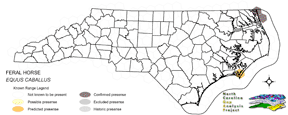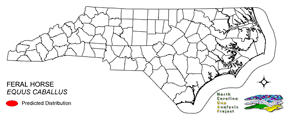
| Taxa: |
| Order: |
| Family: |
| Mammalia |
| Perissodactyla |
| Equidae |
| NatureServe Global Rank: |
| NatureServe State (NC) Rank: |
| G5 |
| SE |
| Federal Status: |
| NC State Status: |
| --- |
| --- |


| Land Unit |
| US Fish & Wildlife Service |
| US Forest Service |
| US National Park Service |
| US Department of Defense |
| NC State Parks |
| NC University System |
| NC Wildlife Res. Com. |
| NC Forest Service |
| NC Div. of Coastal Mgmt. |
| Local Governments |
| Non-Governmental Org. |
| Other Public Lands |
| Private Lands |
| GAP Status 1-2 |
| All Protected Lands |
| Statewide |
| Hectares |
| 786.15 |
| 0.00 |
| 0.00 |
| 2,950.29 |
| 0.00 |
| 0.00 |
| 0.00 |
| 0.00 |
| 101.61 |
| 0.00 |
| 148.14 |
| 0.00 |
| 4,858.47 |
| 3,986.19 |
| 3,986.19 |
| 8,844.66 |
| Acres |
| 1,942.62 |
| 0.00 |
| 0.00 |
| 7,290.32 |
| 0.00 |
| 0.00 |
| 0.00 |
| 0.00 |
| 251.08 |
| 0.00 |
| 366.06 |
| 0.00 |
| 12,005.54 |
| 9,850.09 |
| 9,850.09 |
| 21,855.63 |
| % of Dist. on |
| Prot. Lands |
| 19.7 % |
| 0.0 % |
| 0.0 % |
| 74.0 % |
| 0.0 % |
| 0.0 % |
| 0.0 % |
| 0.0 % |
| 2.5 % |
| 3.7 % |
| 3.7 % |
| 0.0 % |
| 0.0 % |
| 100.0 % |
| ----- |
| ----- |
| % of Dist. on |
| All Lands |
| 8.9 % |
| 0.0 % |
| 0.0 % |
| 33.4 % |
| 0.0 % |
| 0.0 % |
| 0.0 % |
| 0.0 % |
| 1.1 % |
| 0.0 % |
| 1.7 % |
| 0.0 % |
| 54.9 % |
| 45.1 % |
| ----- |
| ----- |
|
NATURE SERVE GLOBAL HABITAT COMMENTS: In West, shrubby sagebrush plains and mountains, juniper woodland; ranges include grazing area, shelter, water, and shade (Slade and Godfrey 1982). Often on ridgetops. |
| Code | Name | Description | NC Natural Heritage Program Equivalent |
| 378 | Ocean Beaches | Open beach sand. | Upper Beach |
| 3 | Tidal Marsh | Fresh and brackish tidal marshes, including cord grass, wild rice, sawgrass and needlerush alliances. | Brackish Marsh, Interdune pond, Maritime wet grassland |
| 124 | Maritime Scrubs and Tidal Shrublands | Coastal shrubs including wax-myrtle, swamp rose, alder, yaupon, and greenbriar. | Maritime Shrubs, Salt Shrub |
| 375 | Hypersaline coastal salt flats | Tidal flats within salt marshes, including saltmeadow cordgrass or sea-purslane dominated alliances. | Salt Marsh |
| 372 | Interdune Herbaceous Wetlands | Dune swales with permanently flooded to intermittently exposed hydrology. Species composition depends on salinity and can include cut grass, spike-rush, mosquito fern, and hornwort. | Interdune Pond, Maritime Wet Grasslands |
| 371 | Maritime Grasslands | Dune grass community consisting of sea oats and beach grasses. | Dune grass, Maritime dry grassland |
| 126 | Interdune Wooded Depression Swamp | Includes swamps dominated by sweetbay and swampbay or dogwood dominated forests. | Maritime Shrub Swamp, Maritime Swamp Forest |
| 380 | Coastal Plain Fresh Water Emergent | Emergent vegetation in fresh water seepage bogs, ponds and riverbeds of the coastal plain. Includes alliances dominated by sedges, eelgrass, as well as cane found in unforested cane-brakes. | Small Depression Pond, Sandhill Seep, Floodplain Pool, Unforested Floodplain Canebrake, Riverscour Prairies, Vernal Pools |
| 205 | Agricultural Pasture/Hay and Natural Herbaceous | Farm fields used for pasture grass or hay production, as well as old fields dominated by native and exotic grasses. | No equivalent |
|
Eberhardt, L. L., A. K. Majorowicz, and J. A. Wilcox. 1982. Apparent rates of increase for two feral horse herds. J. Wildl. Manage. 46:367-374.
Monagan, D. 1982. Horse of a different culture:when horses return to the wild, does their ancient nature reappear? Science 82 3(4):46-53. Slade, L. M., and E. B. Godfrey. 1982. Wild horses. Pages 1089-1098 in Chapman, J. A., and G. A. Feldhamer, eds. Wild mammals of North America. Johns Hopkins Univ. Press, Baltimore. Jones, J. K., Jr., et al. 1992. Revised checklist of North American mammals north of Mexico, 1991. Occas. Pap. Mus., Texas Tech Univ. (146):1-23. Woodward, S. L., and D. P. Sponenberg. 1992. Feral livestock in America:identification of populations important for the conservation of genetic diversity. Abstract, 6th Annual Meeting of the Society for Conservation Biology, p. 148. Wilson, D. E., and D. M. Reeder (editors). 1993. Mammal Species of the World:a Taxonomic and Geographic Reference. Second Edition. Smithsonian Institution Press, Washington, DC. xviii + 1206 pp. Bowling, A. T., and R. W. Touchberry. 1990. Parentage of Great Basin feral horses. J. Wildl. Manage. 54:424-429. Garrot, R. A., and L. Taylor. 1990. Dynamics of a feral horse population in Montana. J. Wildl. Manage. 54:603-612. Seal, U. S., and E. D. Plotka. 1983. Age-specific pregnancy rates in feral horses. J. Wildl. Manage. 47:422-429. Kirkpatrick, J. F., I. K. M. Liu, and J. W. Turner, Jr. 1990. Remotely-delivered immunocontraception in feral horses. Wildl. Soc. Bull. 18:326-330. Kramer, R. J. 1971. Hawaiian land mammals. Charles E. Tuttle Co., Rutland, Vermont, and Tokyo, Japan. Zarn, M., T. Heeler, and K. Collins. 1977. Wild free roaming horses--status of present knowledge. USDI Bureau ofLand Manage., USDA For. Serv., DSC Federal Center, Tech. Note 294. Boyles, J. S. 1986. Managing America's wild horses and burros. J. Equine Vet. Sci. 6:261-265. Ganskopp, D., and M. Vavra. 1986. Habitat use by feral horses in the northern sagebrush steppe. J. Range Manage. 39:207-212. Waring, G. T. 1983. Horse behavior:the behavioral traits and adaptations of domestic and wild horses, including ponies. Park Ridge:Noyes. 292 pp. Berger, J. 1986. Wild horses of the Great Basin. Social competition and population size. Univ. Chicago Press, Chicago. xxii + 326 pp. Tomich, P. Q. 1986. Mammals in Hawai'i. A synopsis and notational bibliography. Second edition. Bishop Museum Press, Honolulu. 375 pp. Garrott, R. A. 1991. Feral horse fertility control:potential and limitations. Wildl. Soc. Bull. 19:52-58. Garrott, R. A., T. C. Eagle, and E. D. Plotka. 1991. Age-specific reproduction in feral horses. Can. J. Zool. 69:738-743. Garrott, R. A., D. B. Siniff, and L. L. Eberhardt. 1991. Growth rates of feral horse populations. J. Wildl. Manage. 55:641-648. Garrott, R. A. 1991. Sex ratios and differential survival of feral horses. J. Anim. Ecol. 60:929-937. Goodloe, R. B., et al. 1991. Genetic variation and its management implications in eastern U.S. feral horses. J. Wildl. Manage. 55:412-421. Kirkpatrick, J. F., and J. W. Turner, Jr. 1991. Compensatory reproduction in feral horses. J. Wildl. Manage. 55:649-652. Turner, J. W., Jr., and J. F. Kirkpatrick. 1991. New developments in feral horse contraception and their potential application to wildlife. Wildl. Soc. Bull. 19:350-359. |
For more information please contact them at:
NC-GAP Analysis Project
Dept. of Zoology, NCSU
Campus Box 7617
Raleigh, NC 27695-7617
(919) 513-2853
www.basic.ncsu.edu/ncgap